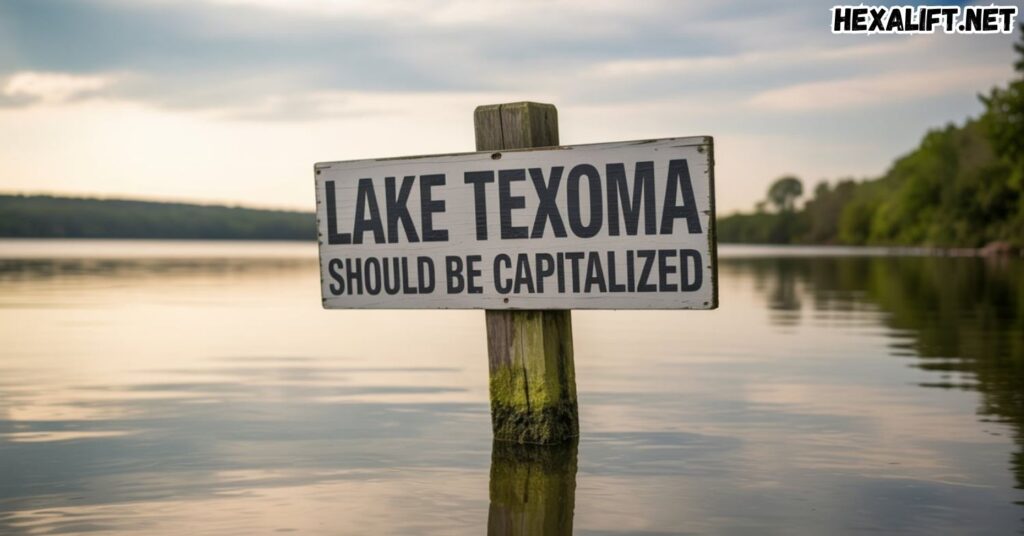When it comes to writing about geographical names, clarity and accuracy are essential. You might wonder why you should always capitalize Lake Texoma or other geographical features.
In this article, we’ll explore the importance of proper nouns in geography, specifically focusing on the capitalization rules that govern them. Let’s dive into the rules and nuances of capitalization, ensuring your writing remains professional and clear.
The Nature of Proper Nouns in Geography
Proper nouns serve a crucial role in identifying specific entities. Unlike common nouns, which denote general items or concepts (like “lake” or “river”), proper nouns refer to unique names, like “Lake Texoma” or “Mississippi River.” This distinction is vital in geography, where clarity often relies on precise naming.
Key Characteristics of Proper Nouns:
- Unique Identification: Proper nouns point to specific entities, making them easily recognizable.
- Capitalization: They always begin with an uppercase letter, distinguishing them from common nouns.
- Cultural Significance: Many proper nouns also carry historical or cultural weight, making them important in various contexts, from travel writing to academic papers.
For instance, when you mention Lake Texoma, you’re not just referring to any lake; you’re talking about a significant body of water located on the Texas–Oklahoma border, known for its recreational activities and natural beauty.

Why Lake Texoma Must Always Be Capitalized
Understanding why to capitalize Lake Texoma goes beyond simple grammar rules. This body of water is a named entity that represents a specific location.
Reasons for Capitalization:
- Official Recognition: “Lake Texoma” is its official name; therefore, it must be capitalized.
- Clarity in Communication: Capitalization helps readers immediately recognize the reference as a specific location rather than a generic term.
- Consistency: Maintaining capitalization across all references enhances readability and professionalism.
Example: Writing “I went fishing at lake Texoma” diminishes the significance of the location. Instead, say, “I went fishing at Lake Texoma,” which acknowledges its unique status.
The Official Rules for Capitalizing Geographical Names
Following established grammar rules is crucial for maintaining clarity and professionalism in writing. The capitalization rules for geographical names are straightforward but essential.
General Guidelines:
- Capitalize all significant words in a geographical name. For example, “Lake Texoma” and “Mount Everest.”
- Common nouns that appear in a proper noun should be capitalized only if they are part of the official name. For instance, “Lake Superior” but “the lake” when referred to generically.
- Always capitalize the names of countries, cities, states, and specific geographical features.
Table: Capitalization Rules for Geographical Names
| Geographical Feature | Example | Capitalization Rule |
|---|---|---|
| Lake | Lake Texoma | Capitalize both words |
| Mountain | Mount Kilimanjaro | Capitalize both words |
| River | Mississippi River | Capitalize both words |
| Country | United States | Capitalize both words |
| City | San Francisco | Capitalize both words |
Following these rules ensures that your writing remains accurate and easy to understand.
Common Mistakes in Capitalizing Lake Texoma
Even seasoned writers sometimes trip up on capitalization, particularly with geographical names. Here are some common mistakes to avoid:
- Using lowercase for common nouns: Writing “lake texoma” instead of “Lake Texoma” undermines its significance.
- Inconsistent capitalization: Switching between “Lake Texoma” and “lake Texoma” can confuse readers.
- Ignoring the context: In casual communication, it might seem less important, but maintaining proper capitalization is essential in professional and academic writing.
Examples of Mistakes:
- Incorrect: “I love visiting lake texoma for fishing.”
- Correct: “I love visiting Lake Texoma for fishing.”
These errors can diminish the professionalism of your writing and lead to misunderstandings.

Step-by-Step Guide to Writing Lake Texoma Correctly
To ensure you’re consistently capitalizing Lake Texoma and other geographical names correctly, follow this simple guide:
Step 1: Identify the Proper Noun
Always recognize whether the name refers to a specific place. If it’s a unique geographical feature, it’s likely a proper noun.
Step 2: Capitalize the Name
Remember to capitalize both the significant parts of the name. For example, “Lake” and “Texoma.”
Step 3: Context Matters
Consider the context in which you’re writing. If it’s formal, adhere strictly to capitalization rules. In casual writing, while it might seem less critical, maintaining consistency is still important.
Step 4: Edit and Proofread
Always review your writing for grammatical correctness. Use tools for spelling verification and grammar checks to catch any mistakes.
Example Sentences:
- Correct: “The Lake Texoma area offers numerous recreational activities.”
- Incorrect: “Many people enjoy boating on lake texoma.”
This guide will help you maintain clarity and professionalism in your writing.
Why Capitalization Matters Beyond Grammar
Capitalization is not merely a matter of following rules; it holds significant meaning in communication. The correct use of capitalization in geographical names contributes to:
Clarity
Proper capitalization helps convey your message clearly. When readers see “Lake Texoma,” they immediately understand it’s a specific location, avoiding any potential confusion with generic terms.
Credibility
Using correct grammar enhances your credibility as a writer. Whether in academic writing, journalism, or professional documents, attention to detail adds to your authority.
Consistency
Maintaining consistency in capitalization across your writing fosters a professional tone. Readers appreciate a well-structured document that adheres to established norms.
Professionalism
Correctly capitalizing geographical names reflects your commitment to professionalism. It shows that you respect the subject matter and your audience.

Conclusion
In summary, understanding and applying the rules of capitalization for geographical names, such as Lake Texoma, is essential for clear and effective communication.
Proper nouns play a vital role in identifying unique entities, and following established grammar rules enhances both readability and credibility.
By consistently capitalizing Lake Texoma and other geographical names, you demonstrate professionalism and respect for your audience. So next time you write about this beautiful lake or any other geographical feature, remember the importance of proper capitalization.
FAQs
What are other examples of geographical proper nouns?
Some examples include:
- Lake Michigan
- Mount Everest
- Nile River
- Lake Victoria
How can I remember the rules for capitalization?
A simple tip is to always ask if the name refers to a specific entity. If it does, capitalize it!
Are there exceptions to these capitalization rules?
While most geographical names follow standard rules, some local or informal names might not require capitalization. Always refer to style guides for specific cases.
Why do some people still capitalize common nouns in place names?
Some may do this out of habit or lack of understanding of the rules. It’s essential to educate oneself on proper usage for effective communication.
By grasping the nuances of capitalization, you not only improve your writing but also enhance your ability to communicate clearly and effectively about important geographical features like Lake Texoma.
Read more knowledgeable blogs on Hexa Lift

Holly Wallace is a Duolingo expert, providing insightful reviews, pricing details, and FAQs. She helps language learners navigate Duolingo effectively, making language learning accessible, engaging, and efficient for users of all levels.








